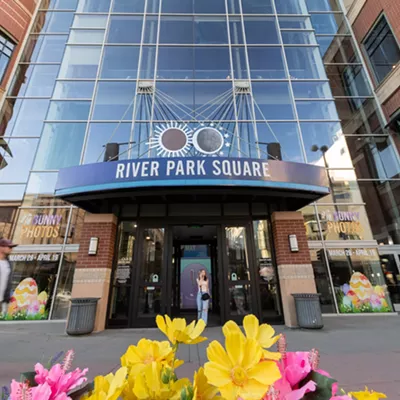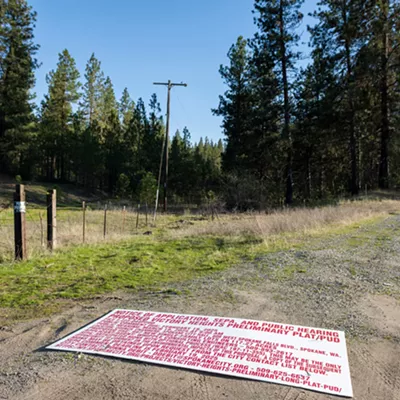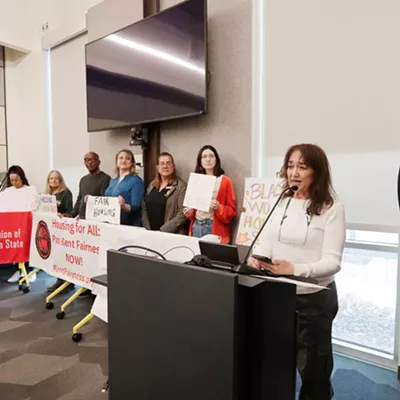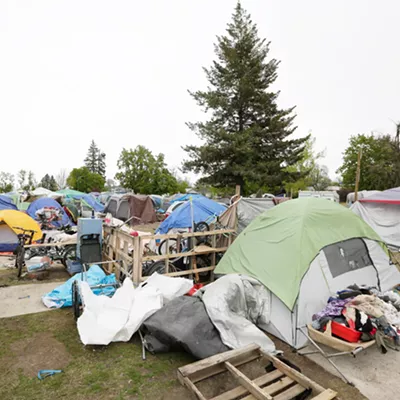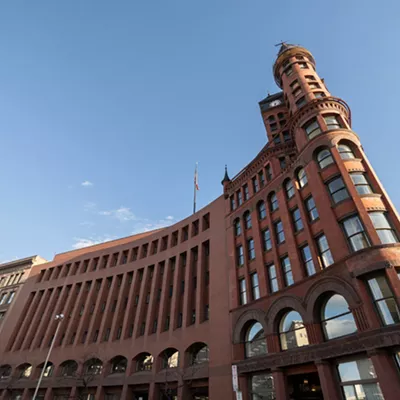
When male prisoners look into the courtyard of Airway Heights Corrections Center from their concrete housing units, they can see correctional officers in full black uniforms standing outside a small metal guardhouse.
They can also see hundreds of zinnias, petunias, roses and honeybees.
"The biggest thing about all of this is that it starts from nothing," says Kelly, an incarcerated man in a bright orange cap who's also the head gardener of two communal flower beds.
"In the last year, we've gone from flat hardpan and weeds — to this," he says, motioning to one garden, which now holds over 600 square feet of near-impenetrable blossoms.
(Kelly and the other incarcerated men quoted in this story will be referenced by their first names only to avoid retraumatizing their victims, and also at the advice of prison rehabilitation experts. There is no way to erase the harm done, including murder and child abuse. But experts stress the importance of avoiding fixating on people's crimes, to allow for a viable path toward rehabilitation.)
Smaller flower beds were started about three years ago and have been expanding every year since.
Four other men in the state prison are preparing nearby ground for another addition. Hardened soil will need to be amended with plenty of compost. That compost will come from a handful of other incarcerated gardeners participating in the prison's sustainability program, who take grass clippings from the yard and food scraps from the commissary and convert them into nutrient-dense, all-natural fertilizer.
"You can use all of the material that we usually throw away," Kelly says. "You take all of that stuff and you work it, and you can turn it into rich, beautiful soil that produces this type of flowering."
In 2003, an organization called the Sustainability in Prisons Project, or SPP, emerged from Evergreen State College in Olympia. The project's goal was to bring science and conservation education to the 12 state prisons across Washington. SPP has since been welcomed into each facility, including Airway Heights Corrections Center, a medium and minimum security prison for more than 2,200 men.
Across the state, SPP projects vary, including rearing endangered butterflies, rehabilitating turtles, teaching water conservation techniques and training rescue dogs.
Other sustainability programs at the Airway Heights prison include forestry and firewood donation programs, plus recycling and refurbishing computers. But the pillars are their food and flower gardens, as is the case at most prisons in the state.
"There tends to be space. There tends to be broad interest among the staff," says Kelli Bush, the co-director of SPP statewide. "Many folks have some experience with gardening, whether they're incarcerated people or staff."
The gardens at Airway Heights Corrections Center are experimental grounds not only for composting and conservation techniques, but for understanding how greenspace, access to nature, and science education can impact mental health, recidivism rates, and rehabilitation in prison.
Can limited access to the outdoors, even while locked up, promote healing? What spaces are helpful in rehabilitating someone for the "outside" world? Can gardening transform behavior enough that an incarcerated person is more likely to reenter society as a healthier version of themself and not reoffend?
"We don't ever want to forget that many of the folks who are incarcerated have caused some really serious harm," Bush says. "[But] if it were going to work to simply make conditions miserable for people, if that were going to deter them and make them less likely to cause harm, then that model would have worked a long time ago and we wouldn't have the rates of incarceration that we have."
Studying recidivism rates is difficult, she says, because the chance of reoffending is affected by many different factors, including social circles, having a place to stay, drug use and employment opportunities. According to a 2018 study by the federal Bureau of Justice Statistics, five out of six state prisoners are rearrested within nine years of their release.
Bush says the kind of education that SPP provides has the potential to reduce the likelihood of reoffending by 43%. Researchers in the U.K. have shown that more greenspace correlates with less violence in prisons, plus greater staff retention.
But the most important number, in Bush's mind, is even larger.
"About 96% of people who are incarcerated are going to be released," she says. "Who do we want as our neighbors? If we don't create a healthy environment where people can reflect, heal, change, grow, transform, then they're coming back out to be our neighbors, potentially in worse condition. I don't want that. I want folks that come out in better condition. I want folks that have reflected and done some healing."
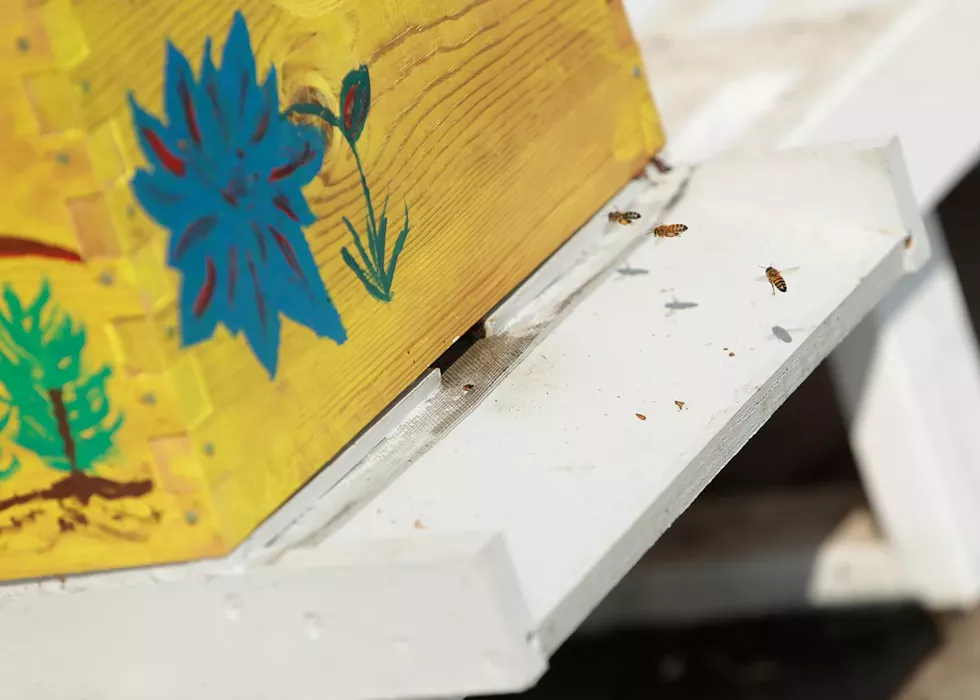
GROWING GARDENS
"Morning," Patrick Strand greets two incarcerated men in gray T-shirts as he strolls through the Airway Heights prison courtyard in a polo and sporty sunglasses."Good morning," they both respond, each making eye contact with the guard. Strand makes a point to say hello to everyone he walks past. He has worked at Airway Heights Corrections Center for a decade, but two years ago he took on the role of sustainability specialist. He's one of the first dedicated prison sustainability officers in the state.
Part of his job is coordinating the work in the courtyard flower gardens and the greenhouse in the back of the compound, where all the plant starts are raised and the compost is made. He hires the men who get to participate, noting he chooses team members who have some experience growing and can "play well with others."
In addition to his administrative tasks, Strand helps pull weeds, gives advice on carbon and nitrogen ratios for compost, and offers tips on which flowers like to grow next to other flowers.
"I do get my hands dirty out there," he says. "I believe in leading by example. If I told a bunch of people to pull weeds, I should probably pull some, too. But again, it's not my job. I need to remember my role. But I can't help it. I'm a farm kid myself."
On the way to the produce garden, Strand stops by one of the "unit gardens," small flower beds in front of each dwelling unit that are designed and cared for by some of the men who live inside. He chats with a man pulling dead blooms off purple petunias.
"When you prune your roses, will you let me know so I can propagate them?" Strand asks.
Through a set of guarded doors and behind the laundry facility, there's a greenhouse with dozens of propagated rose stems already. The ones that survive will help fill in new or expanding flower beds early next spring.
The greenhouse is in the corner of a 2-acre field that's filled with a couple dozen rows of onions, tomatoes, squash, pumpkins, spinach, kale, carrots, turnips, radishes, cucumbers, strawberries and melons.
Ten men are responsible for the produce garden, and they're allowed to work out here under minimal supervision all day, five days a week during the growing season. They grow thousands of pounds of produce, most of which is donated to the Women's and Children's Free Restaurant and Community Kitchen in Spokane.
The team is also in charge of three beehives and six vermiculture bins. They gather honey from the bees, and use the worms to help turn waste from kitchen scraps back into fertile soil. Because fertilizer, pesticides and large tools are not allowed due to security risks, all the food is grown with compost, a few hand tools, and a healthy population of pollinators.
The vegetable rows are far from the prison's intercom, which blares announcements over the courtyard every five to 15 minutes, the noise reverberating off the smooth concrete surfaces with a distinctly dystopian echo. But here among the tomatoes and turnips, you can't hear it. On the other side of the fence, you can see a new neighborhood.
"I could be out here all day," says Josh, the vegetable garden lead, who has been serving time for more than 15 years. He first started working with plants eight years ago through an SPP environmental literacy program called Roots of Success.
"I mean, we get paid almost $150 a month to be out here," he says, "but I easily could do this for free."
Roy, the newest member of the team who's been working since April, says it's almost possible to forget that you're in prison while you're out here.
"Inside is a completely different world compared to here, from the inmate population to the general energy," Roy says. "Out here, you get to interact with the ground and the air outside. You're planning stuff, and you get to have a little more control, where everything in there is very ordered and very scheduled and very, very much the same."
Josh, who is in recovery from substance use, is also a certified peer-to-peer counselor. The way he talks about gardening is strikingly similar to the way he talks about recovery.
"A person might typically think that I don't have a lot of ability to make changes in my life. But here, I can feel like I have a sense of agency, I can do things, I can take action, and I can see changes happen," Josh says. "It's just a microcosm. If any of us take that same mindset into just trying to be better people, to see that the little choices that we make on a day-to-day basis — even though there's a lot of hard work involved, but it's all something we're doing together, not just by myself as an individual — then we could see those positive changes happening over a period of time."

PATHS FORWARD
Washington state prisons are far from the only correctional institutions to incorporate plants into daily life. One of the most famous examples is the GreenHouse on Rikers Island, which started more than 30 years ago and is one of the oldest therapeutic horticulture programs in the country. It's run by the Horticultural Society of New York, in New York City's largest jail.The Hort, as the society calls itself, doesn't set out to make jail an ideal place to be. But it aims to offer stability and emotional management tools for people in constant flux at Rikers while they await their trial.
Over half the people on the island are diagnosed with a mental health disorder that often co-occurs with drug abuse. The volatility of their stay in jail can make things worse instead of encouraging rehabilitation. (New Yorkers have voted to close Rikers Island by 2026 due to concerns about human rights violations.)
Close to 2 million people are incarcerated in the United States, according to the Prison Policy Initiative, a nonpartisan think tank.
Anywhere from 65% to 80% of incarcerated people deal with addiction, while 30% to 40% struggle with mental health issues, says Marc Stern, an associate professor of health systems and population health at the University of Washington and the former assistant secretary for health care at the state Department of Corrections.
But studying the effect of greenspace on the mental health and behavior of the incarcerated population to rigorous scientific standards is difficult.
The National Science Foundation requires academic studies to create a control group — that is, a group of people who don't have access to the treatment — in order to accurately measure the difference in those who do receive treatment. Studies also typically require participants to be randomly assigned to treatment or control groups.
But participation in SPP gardening programs like the one in Airway Heights, which has to be applied to and earned, is anything but random.
"We can't see a path forward where we compromise our values and mandate that you must garden even if you're not interested in gardening, or you must work with butterflies if you're not interested in that," Bush says. "It's tough to find the true comparison group, because you'd essentially have to say 'You get access to nothing during your incarceration.' That feels unethical, right?"
Stern suggests that perhaps prison research should explore the effect prison spaces have on the people who work there. It might be an easier population to study academically, and anything that decreases stress on staff and reduces guard turnover rates is beneficial to both populations, he says.
"The healthier and more normal these spaces are, the better they are for everybody," Stern says. "Prison health is a public health issue."
Jim Parker has worked at Airway Heights Corrections Center since 1997. He's now the facilities manager of the prison. He says staff members also take advantage of the conservation programs.
"Staff will volunteer to help us with different gardens," he says. "When you're staff that works here, one of the things that you have to do is guard your personal life. So you always look for common ground that you can discuss that doesn't reveal too much personal information but provides something that humans can interact on. I think that the plants provide that."
Dominique Moran, a professor in carceral geography at England's University of Birmingham, is finding new ways to study the effect of greenspace on prison populations.
By mapping and measuring the amount of greenspace across multiple prisons in England and Wales, Moran and her team found that "prisons with a higher percentage of greenspace have significantly lower levels of self-harm, violence and staff absence." They were able to control for various prison population characteristics.
Similar conclusions have been drawn for non-prison populations. A 2002 study from the University of Illinois found that a view of greenspace from a window alone can help inner city girls concentrate on tests and have better impulse control.
A 2022 study across universities, including research by University of Washington's Gregory Bratman, found that childhood neighborhood greenspace was positively associated with emotional intelligence among college students with low-income backgrounds.
However, access to nature is so often associated with other factors, like wealth and family support, that researchers are still trying to tease out how much credit Mother Nature can get.
Scott Frakes retired as the deputy director of prisons for the Washington Department of Corrections in 2015. He then served as director of the Nebraska Department of Correctional Services until 2022. Now, he owns a consulting firm that assesses and advises on new prisons nationwide.
Frakes is committed to pushing for greenspace, which provides a more natural environment as well as opportunities for nurture-focused programs like gardening.
"If you give someone responsibility for a living thing, it usually improves their behavior," he says.
His clients are usually receptive, he says, but the biggest pushback is money.
Bush, however, says that gardening and conservation programs are relatively low cost, and much less expensive than having someone return to prison. If a prison composts its own waste into fertilizer and uses conservative watering techniques, expenses for gardening are usually limited to buying seeds and paying very small salaries.
"Incarceration is costly — anywhere between $63,000 and $67,000 a year per person," she says. "So it's very cost effective, when you think of it that way, to invest in education to prevent that return."
Airway Heights Corrections Center is actually one of the least expensive prisons in the state, with an annual cost per person of just over $51,000 in 2022. Part of that, Frakes says, is because of the energy efficiency designed into the facility, including the composting efforts. The grounds were also designed to allow a minimal number of staff to operate them safely.

TRANSPLANTING
The flowers in Kelly's flower beds can only be 3 to 4 feet tall, so guards can always see everything across the grounds. For the same safety reasons, there can't be any trees in the courtyard.Josh, Roy and the other men who work in the vegetable gardens are allowed to eat whatever fresh produce they'd like during their shifts, but they're strictly forbidden from bringing any of it inside to others.
On Tuesdays, however, they donate some of their harvest to the commissary for everyone to enjoy. By Thursday, there will be plenty more to send to the Women's and Children's pantry. Last year, they donated more than 2,000 pounds of fresh food.
"That was actually a small donation," Strand says. "We had all those wildfires. If I have wildfires, I can't bring incarcerated [men] out because of the air quality. So the garden just gets kind of neglected."
It's not been neglected this year. The tomatoes are bearing so much fruit they're tugging down the ropes meant to support them. Tomato cages or chicken wire aren't allowed in the prison.
Strand and his team have also perfected their compost recipe, carefully timing ratios, temperatures and turnings. With their undivided attention, they're able to turn grass clippings and wood chips into black gold in just two weeks, a process that could take a lazier gardener over a year.
Airway's correctional center was one of the first prisons to have a beekeeping program, which started at the end of 2017. Their colonies almost died off during the COVID pandemic, but two of three hives are back on track, with the third slowly getting healthier.
Josh approaches the smaller, slower colony without any protective gear. He lifts the lid of the box, which is handpainted with pictures and a reminder to "Save the Bees," to check for predatory yellow jackets. He's not very worried about the honeybees themselves.
If you give someone responsibility for a living thing, it usually improves their behavior.
"My experience is the bees just being really docile, as long as we're not being super reckless with handling them," he says. "It seems like there's not really much to worry about."
Some honeybees eventually make their way to Kelly in the courtyard flower gardens, which also get visited by the occasional hummingbird or bumblebee.
"These are my favorite little guys," Kelly says, petting a fuzzy black and yellow pollinator. "They're very gentle, and they're so beautiful. I let them climb on me. They get caught in my beard sometimes."
Airway's prison is getting ready to implement a new conservation program in 2025. The plan is to have men in the greenhouse nurture sagebrush starts that will get transplanted in Central Washington in order to reestablish habitat for the endangered sage grouse.
It will be another way for the men incarcerated here to have a positive impact on those around them, both inside and outside the prison walls.
"If you think about it, being incarcerated means that you have a debt to society to serve," says Joe, who's in charge of growing pumpkins that are donated to schools and children's hospitals in the area. "When you can do something in here that positively impacts the disadvantaged out there, you feel that connection to society — that you can achieve success regardless and despite your past circumstances, your past mistakes."
Even if these men don't become professional landscapers or farmers upon release, Josh says that the skills he's learned growing vegetables may be more transferable than the job training he might get in other programs.
"I was able to work as a clerk for workforce development, where they were doing classes for reentry skills and job-seeking skills," Josh says. "One of the things that I learned helping write resumes for other people is that even though a lot of the skills that I get from the work that I do in here aren't hard skills that directly translate to the community, there's a lot of soft skills that, to me, come to matter more in the long run."
If he's really good at something when he gets out of prison, but after getting a job he doesn't get along with others, doesn't communicate well, and doesn't show up on time or take pride in his work, then it's not likely to work out, Josh says.
"So although this might not be something that directly translates into a specific kind of job that I do out in the community, I look at it in terms of developing the same kind of transferable skills," Josh says. "Self-management skills, being able to communicate with people, working well on a team, managing goals, working with setbacks, and problem solving — all of these different things that I think I can bring with me into different kinds of jobs."
Roy's stay won't be as long as Josh's, but for the next few months he's here, he says the garden is where he feels most restored.
"This is a blessing to be out here," Roy says. "It's very much relaxed and warm. It's hard in there sometimes. So to get away from it all — there's not the crowd, there's not the massive CO presence — we get just each other and this place to dig our hands in the dirt and let all that bad energy go." ♦




